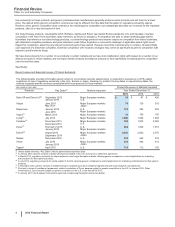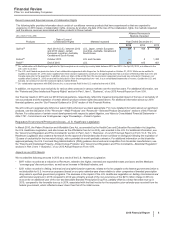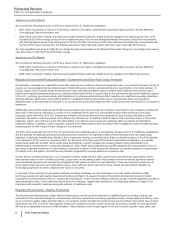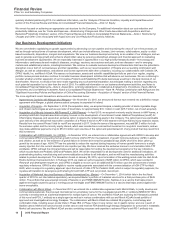Pfizer 2015 Annual Report Download - page 15
Download and view the complete annual report
Please find page 15 of the 2015 Pfizer annual report below. You can navigate through the pages in the report by either clicking on the pages listed below, or by using the keyword search tool below to find specific information within the annual report.
Financial Review
Pfizer Inc. and Subsidiary Companies
14
2015 Financial Report
acquired or recently impaired indefinite-lived brand assets (approximately $145 million as of December 31, 2015). IPR&D assets are high-risk
assets, as research and development is an inherently risky activity. Newly acquired and recently impaired indefinite-lived assets are more
vulnerable to impairment as the assets are recorded at fair value and are then subsequently measured at the lower of fair value or carrying
value at the end of each reporting period. As such, immediately after acquisition or impairment, even small declines in the outlook for these
assets can negatively impact our ability to recover the carrying value and can result in an impairment charge.
Goodwill
As a result of our goodwill impairment review work, we concluded that none of our goodwill was impaired as of December 31, 2015, and we do
not believe the risk of impairment is significant at this time.
Fair value determinations require considerable judgment and are sensitive to changes in underlying assumptions and factors. Our Consumer
Healthcare reporting unit has the narrowest difference between estimated fair value and estimated book value. A hypothetical decrease in the
fair value of our Consumer Healthcare reporting unit of approximately 10% could trigger a potential impairment of its goodwill. Examples of
events or circumstances that could impact the estimated fair value of a reporting unit may include items such as changes in operating results,
anticipated future cash flows, the discount rate, market multiples, among others. Our Consumer Healthcare reporting unit performance and
consumer healthcare industry market multiples are highly correlated with the overall economy and our specific performance is also dependent
on our and our competitors’ innovation and marketing effectiveness, and on regulatory developments affecting claims, formulations and
ingredients of our products. While historical performance and current expectations have resulted in fair values in excess of carrying values, if
our assumptions are not realized, it is possible that in the future an impairment charge may need to be recorded. However, it is not possible at
this time to determine if an impairment charge would result or if such a charge in the future would be material.
When we are required to determine the fair value of a reporting unit, as appropriate for the individual reporting unit, we mainly use the income
approach but we may also use the market approach, or a weighted-average combination of both approaches.
• The income approach is a forward-looking approach to estimating fair value and relies primarily on internal forecasts. Within the income
approach, the method that we use is the discounted cash flow method. We start with a forecast of all the expected net cash flows
associated with the reporting unit, which includes the application of a terminal value, and then we apply a reporting unit-specific discount
rate to arrive at a net present value amount. Some of the more significant estimates and assumptions inherent in this approach include:
the amount and timing of the projected net cash flows, which includes the expected impact of technological risk and competitive, legal and/
or regulatory forces on the projections, as well as the selection of a long-term growth rate; the discount rate, which seeks to reflect the
various risks inherent in the projected cash flows; and the tax rate, which seeks to incorporate the geographic diversity of the projected
cash flows.
• The market approach is a historical approach to estimating fair value and relies primarily on external information. Within the market
approach are two methods that we may use:
Guideline public company method—this method employs market multiples derived from market prices of stocks of companies that are
engaged in the same or similar lines of business and that are actively traded on a free and open market and the application of the
identified multiples to the corresponding measure of our reporting unit’s financial performance.
Guideline transaction method—this method relies on pricing multiples derived from transactions of significant interests in companies
engaged in the same or similar lines of business and the application of the identified multiples to the corresponding measure of our
reporting unit’s financial performance.
The market approach is only appropriate when the available external information is robust and deemed to be a reliable proxy for the
specific reporting unit being valued; however, these assessments may prove to be incomplete or inaccurate. Some of the more significant
estimates and assumptions inherent in this approach include: the selection of appropriate guideline companies and transactions and the
determination of applicable premiums and discounts based on any differences in ownership percentages, ownership rights, business
ownership forms or marketability between the reporting unit and the guideline companies and transactions.
Specifically:
• When we estimate the fair value of our four biopharmaceutical reporting units, we rely solely on the income approach. We use the income
approach exclusively as the use of the comparable guideline company method is not practical or reliable. For the income approach, we
use the discounted cash flow method.
• When we estimate the fair value of our Consumer Healthcare reporting unit, we use a combination of approaches and methods. We use
the income approach and the market approach, which we weight equally in our analysis. We weight them equally as we have equal
confidence in the appropriateness of the approaches for this reporting unit. For the income approach, we use the discounted cash flow
method and for the market approach, we use both the guideline public company method and the guideline transaction method, which we
weight equally to arrive at our market approach value.
For all of our reporting units, there are a number of future events and factors that may impact future results and that could potentially have an
impact on the outcome of subsequent goodwill impairment testing. For a list of these factors, see the “Forward-Looking Information and
Factors That May Affect Future Results” section of this Financial Review and Part I. Item 1A “Risk Factors” in our 2015 Annual Report on Form
10-K.
Benefit Plans
The majority of our employees worldwide are covered by defined benefit pension plans, defined contribution plans or both. In the U.S., we
have both Internal Revenue Code qualified and supplemental (non-qualified) defined benefit plans and defined contribution plans, as well as
other postretirement benefit plans consisting primarily of medical insurance for retirees.
























